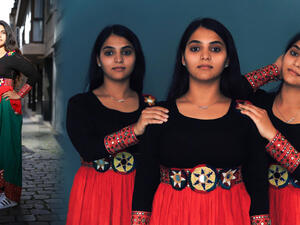How photography has changed the life of a young Colombian refugee
How photography has changed the life of a young Colombian refugee

Colombian refugee José indulges in his love of photography, history and buildings by taking a photo of Castle of Chapultepec Castle in Mexico City.
MEXICO CITY, August 3 (UNHCR) - Fifteen-year-old José Romero* was hooked on photography after taking a short course last year and the Colombian refugee's skill with the camera has already won him a major prize and public exposure in Mexico.
"What I enjoy the most is to photograph objects, above all tall buildings," says José with a big smile. "Just holding the camera, I can feel the adrenaline all over my body. It's an exciting emotion, I don't know how to describe it."
José's family fled the violence in Colombia in the 1990s and eventually reached Mexico City five years ago. The shy young man lives with his mother, sister and three brothers and is about to move to high school, where he looks forward to pursuing his favourite academic subject - history, especially Mexican history.
He discovered his other great love, photography, when he attended a two-day photographic workshop held at Refugee Park, a humanitarian project in Mexico City run by Amnesty International with UNHCR funding. The workshop was one of several activities aimed at promoting culture among refugee children and Mexicans.
Humanitarian photographer Ricardo Ramírez Arriola, a naturalised Mexican who hails from Guatemala and has worked with UNHCR in the region for the past seven years, was a guest instructor.
The professional shutterbug shared his experiences with the refugee children and Mexican youngsters taking part and taught them how to use disposable cameras and how to develop and print photographs. José was entranced by Ramirez Arriola and his art and says he wants to become a photographer and humanitarian worker.
"I greatly admire Ricardo, when I grow up I want to be a photographer like him," says the teenager, who built on the skills taught in the short course. Two of his photos - depicting a friend performing tricks on a scooter - were displayed at an exhibition of work by refugee children.
Ivonne Gonzalez, coordinator of the children's group at Refugee Park, encouraged José to enter a photographic contest last year organised by the Image Centre - part of Mexico's National Council for Culture and the Arts.
Competing against other teenagers from around the country, the young refugee scooped first prize with the photo of his acrobatic scooter-riding friend. He received a digital camera and had his winning photograph displayed at the Technological Museum in Mexico City.
"This is an excellent example of the important role that civil society is playing in the local integration of refugees. Here we have a young urban refugee who brings skill and passion to the artistic expression of photography - and Mexican volunteers who enthusiastically support him", says Marion Hoffmann, UNHCR regional representative in Mexico.
Photographer Ramirez Arriola is also pleased with his protégé's progress. "He is a shy adolescent, so I'm very glad that he has discovered photography. Photography has become his style of expression. Through this art he is able to communicate several sensations and emotions.
"When he holds the camera he is always searching different ideas, angles and he constantly is making experiments. I feel honoured to witness how José has found his passion."
José's next plan is to photograph Mexico City's historic 18th Century Chapultepec Castle, combining his love of buildings, photography and history.
* (Not his real name)
By Gema Jiménez in Mexico City, Mexico









